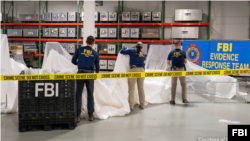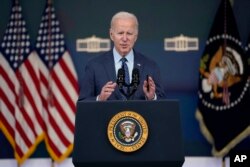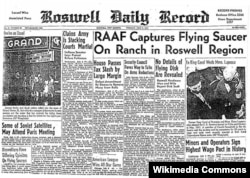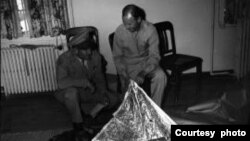Three mystery objects shot down by the U.S. military this month again compelled government officials to tamp down speculation of extraterrestrial connections.
Military and civilian sightings of unidentified flying objects have generated sensational headlines going back to the 1940s, repeatedly prompting reporters to ask government officials for explanations.
House Intelligence Committee Chairman Representative Mike Turner told the Munich Security Conference, "I'm not going to release classified information in saying this: None of the objects shot over North America recently were Martians."
President Joe Biden told a White House briefing: "The intelligence community's current assessment is that these three objects were most likely balloons tied to private companies, recreation, or research institutions studying weather or conducting other scientific research."
On the campaign trail, presidential candidates have promised to make public government secrets about unidentified aerial phenomenon, but that changes once they get elected.
Donald Trump acknowledged being briefed on the topic, saying, "We're watching for extraterrestrials," while both stating that he did not particularly believe people who claimed to have seen UFOs and also wondered out loud if they're real.
Barack Obama told a late-night talk show that he asked about aliens after taking office and was told the U.S. government was not keeping aliens in a lab, as some ufologists have claimed. Obama did confirm that there are objects in the sky that move in an unexplainable manner.
George W. Bush told a late-night TV talk show that he would not reveal anything he had been told on the topic as president, even to his curious daughter.
Bill Clinton expressed interest in the phenomena, saying on a visit to Northern Ireland in 1996, "If the United States Air Force did recover alien bodies, they didn't tell me about it, either, and I want to know."
Jimmy Carter spoke of his own close encounter with a hovering, luminous object that changed from blue to red in 1969, a year before being elected governor of Georgia, calling it "the darndest thing I've ever seen." Among the first candidates to promise the release of "every piece of information" on the subject, he reversed course following his 1976 election, saying public disclosure might have "defense implications" and pose a threat to national security.
Harry Truman may have been the U.S. president with the most firsthand knowledge of unexplained aerial phenomena as he was commander-in-chief in July of 1947 when something unusual occurred in Lincoln County, New Mexico.
Roswell and UFOs
Decades later, I went there to interview some who claimed to have seen what happened.
Roswell, New Mexico has turned its UFO legacy into a tourist industry. Visitors to the sleepy desert town are greeted by dozens of pairs of walnut eyes gazing at them from alien-illustrated billboards and in windows of Roswell's fast-food joints, gift shops and motels.
The International UFO Museum and Research Center contains historical displays, documents and photographs alongside tacky UFO-themed art. While the museum may have converted few skeptics, conversations with some of those who were in the Roswell area in the summer of 1947 had me giving their tale a bit of credence.
Nearly all Roswell's witnesses had kept the story to themselves for about a half a century, fearing ridicule, remembering secrecy oaths they had signed or threats from military officers.
Walter Haut was 76 years old when I met him in 1999. One of the few survivors at the core of the story, he paced the corridors of the Main Street attraction he helped create. Haut was a member of the elite 509th Composite Bomb Group, at the time the world's only atomic air force, which had dropped the August 1945 warheads on Hiroshima and Nagasaki. He spent the early post-war era as Roswell Army Air Field's public information officer. On July 8, 1947, he was ordered by the commanding officer to issue an unprecedented press release stating the military had recovered a crashed flying saucer.
By that time, flying saucers or flying discs had been in the headlines for days. (The acronym UFO for unidentified flying object was decades away. During World War Two, pilots had referred to the mysterious aircraft as "foo fighters.") The Roswell incident was not an isolated one. During the previous two weeks there had been sightings in nearly every one of the 48 states.
Within hours of First Lt. Haut's noontime press release, the story was on the Associated Press and United Press wires and the front pages of western U.S. afternoon newspapers. Later that day, high brass from outside New Mexico issued a new explanation that, in essence, said: Never mind, it's just a balloon.
The controversy is whether the subsequent announcement was the truth or a cover story and whether Col. William Blanchard's order to Haut to distribute the flying saucer press was the result of some error or misunderstanding. Haut told me, "Very definitely no," Blanchard did not make a mistake. "I'm sure Blanchard saw parts of the material."
The debris of whatever came from the sky was scattered over a remote ranch about 135 kilometers northwest of Roswell. It was first spotted by rancher Mac Brazell, who was out on horseback July 3 inspecting the aftermath of an intense thunderstorm the night before. He picked up some of the baffling material and rode to see his closest neighbors, the Proctors, eight miles away.
"Now I'd say it looked like plastic. But back then we didn't have plastic," said Loretta Proctor, who was 85 when I spoke with her during my New Mexico visit.
Proctor, who died in 2013, said the material was tannish-brown with a purplish section containing figures. While extremely flexible, she said it couldn't be burned or broken, even with hardy ranch tools.
A mother of eight who drove a school bus over dirt roads for nearly 20 years, Proctor bristled at skeptics who portrayed Brazell and her family as confused, naïve country bumpkins. She pointed out the U.S. military "has told at least three different stories" about what crashed next to her ranch.
The Pentagon's latest version, released in 1994, said the crash was part of Project Mogul, an attempt to develop balloons that would fly at a constant high altitude to conduct acoustic monitoring of expected Soviet nuclear blasts.
Glenn Dennis was a young mortician in Roswell in 1947. He believes the air force may have found alien bodies in the New Mexico desert as he received several phone calls from the Roswell base July 8 asking about acquiring child-size caskets and about preserving tissue in a body that had been out in the sun for a few days. He told me he was transporting a slightly injured enlisted man back to the base hospital later that day and saw strange debris in a slightly ajar door in the rear of a field ambulance and an unprecedented level of security inside the base hospital. He spotted a friend, who he described as a deeply religious nurse, in a corridor holding a towel to her face.
"She screamed at me, 'Glenn, get out as fast as you can!'" Dennis recounted. Moments later, he says he was threatened by an army captain who told him not to start rumors and if he mentioned what had happened, "somebody will be picking your bones out of the sand."
The following day he had lunch with the nurse from the base. He said she told him that she had been called in to take dictation in a makeshift autopsy theater that began with the words "crash bag, two small mutilated bodies." Dennis said the convent-educated medical professional was nearly in shock as she sketched a four-fingered alien with a face remarkably similar to the big-eyed slit-mouthed creature that decades later became ubiquitous on T-shirts, key chains and coffee cups. Dennis said when he tried to ring her back at the base later that afternoon, she had vanished. Later in the week he was told she was no longer assigned to the base, and he never heard from her again.
"She asked me to take a secret oath never to reveal her name," said Dennis, who was 73 when I spoke with him. "So I never did." He died in 2015.
People's recollections of events can change over time and be affected by things they hear, but I have encountered thousands of people during my half century as a journalist and believe I have developed a decent ability to detect when an interviewee is evasive, exaggerating or lying. Haut, Brazell and Dennis came across as forthright as any individuals I have interviewed.
Nonetheless, after decades of research, UFO investigators have failed to produce a smoking gun proving that aliens crashed at Roswell. There is one tantalizing piece of evidence, perhaps not a smoking gun, that may have been staring skeptics in the face for decades.
A few months before I showed up in Roswell in 1999, there was a digital enhancement of an AP photograph in the July 8, 1947 Ft. Worth Star-Telegram showing Air Force Brigadier General Roger Ramey and Col. Thomas DuBose posing next to pieces of a radar reflector from a weather balloon. In the general's hand is what appears to be a telegram, which was previously unreadable. Various experts examining the digital enhancement pieced together unencrypted phrases from the teletype print that they contend include "Roswell NMEX," "victims," "emergency powers," "weather balloons," "story" and "disk."
Skeptics say some of those words are more likely people seeing what they wanted to see and the telegram could have been a news dispatch, rather than a military message.
The library of the University of Texas at Arlington says there is a $10,000 reward offered by a private individual for the "first person or group/lab that can provide a definitive read of the Ramey memo." (E-mail: rameymemo@gmail.com if you have success).
"No one has collected the reward," Kevin Randle, a member of the library's research team about the memo, tells VOA.
"We did a complete new scan of the [photograph's] negative just before COVID but that didn't real any new details," says Randle, a retired military officer and author of books about UFOs and the Roswell incident.
Another member of the research team, Brenda McClurkin, who was the head of the library's special collections and archives, concurs.
"Regardless of all the advances in technology the mystery still prevails," she says.
Steve Herman is VOA's chief national correspondent. He researched the Roswell Incident in 1999 while working for the Discovery Channel.



















